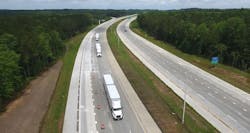Volvo Trucks, FedEx successfully demonstrate truck platooning on North Carolina tollway
Volvo Trucks North America, together with FedEx and the North Carolina Turnpike Authority, used advanced driver assistance system (ADAS) technology to conduct on-highway truck platooning as part of ongoing research collaboration.
Volvo Trucks North America announced the successful on-highway demonstration of its truck platooning technology. The company has been working closely with FedEx and the North Carolina Turnpike Authority (NCTA) to expand on-highway operations of Volvo’s Cooperative Adaptive Cruise Control (CACC) in the United States on NC 540, the Triangle Expressway. This reportedly marks the first public on-highway showcase of platooning technology between a major truck manufacturer and a transportation company in the United States.
“Volvo Trucks has long supported platooning because it benefits freight companies and professional drivers alike through safer, more fuel-efficient operations,” said Per Carlsson, acting president of Volvo Trucks North America. “We continue preparing for deployment of trucks with greater vehicle-to-vehicle communication capabilities that support higher levels of ADAS. We know these technologies will be part of our future, but exact timing depends on many things, namely regulations, infrastructure, safety standards, and market demand.”
The “platoon” consisted of three trained, professional truck drivers in Volvo VNL tractors, each pulling double 28-foot trailers. Through CACC, a wireless vehicle-to-vehicle (V2V) communication technology, the tractors and trailers remained in constant communication. The tractors and trailers traveled at speeds of up to 62 mph while keeping a time gap of 1.5 seconds, maintaining a closer distance than what is typical for on-highway tractors. Staged and unplanned vehicle cut-ins demonstrated how the technology handles common traffic situations.
“Volvo’s V2V technology is based on Dedicated Short-Range Communication (DSRC), which has proven its capability to perform well in the V2V environment," said Keith Brandis Volvo Trucks North America vice president for product planning. “Dedicated bandwidth within the 5.9GHz spectrum is critical for the successful deployment of V2V application, like truck platooning.”
This demonstartion was the result of an ongoing research collaboration. Since April 2018, three Volvo VNL tractors have been paired with various combinations of FedEx trailers to simulate real-world routes and trailer loads while traveling on NC 540. The potential benefits of platooning that are being studied during this collaborative research include faster responses to hard braking while maintaining safety and fuel efficiency.
“FedEx was built on innovation and it continues to be an integral part of the FedEx culture and business strategy,” said Gloria Boyland, corporate vice-president, operations and service support, FedEx Corporation. “We are pleased to collaborate with Volvo Trucks and the North Carolina Turnpike Authority to learn more about how platooning technology can benefit our team members while improving fuel efficiency for our fleet.”
The vehicle-to-vehicle communication system helps reduce the reaction time for braking and enables vehicles to follow closer, automatically matching each other’s speed and braking. The advanced technology is meant to serve as an aid--not a replacement--for skilled professional truck drivers.
When trucks can drive closely behind one another, fuel efficiency is improved as a result of reduced drag. Drag accounts for up to 25% of a truck’s total fuel consumption, and the closer the trucks drive to each other, the greater the fuel-saving potential. Reducing the traveling distance between vehicles also allows for greater highway utilization, helping alleviate traffic congestion.
“This collaboration demonstrates the Turnpike Authority’s commitment to invest in the safety of customers with state of the art technology that could become an invaluable tool for transportation,” said NCTA Executive Director Beau Memory. “With some of the most advanced roadways in the nation, the Turnpike Authority wants all drivers to have every tool and technological advancement necessary to reach their destination safely and efficiently.”
NC 540, due to its proximity to Volvo Trucks’ North American headquarters and its designation as a proving ground for advanced vehicle technology, is an excellent demonstration site for the Volvo platooning technology, providing invaluable insights for all parties involved in this process. NC 540 is one of 10 locations around the country that the US Department of Transportation has designated for demonstrating advanced vehicle technologies, like platooning, through research initiatives such as this one.
Volvo Trucks and FedEx plan to continue developing the Volvo CACC technology on NC 540 into the foreseeable future with the goal of continuing to learn about the potential benefits offered by vehicle platooning. Additionally, this advanced testing will allow the participants to adapt to the technological and regulatory developments that will ultimately determine the commercial viability of platooning technology in the United States.
